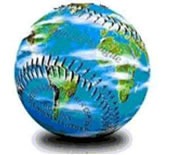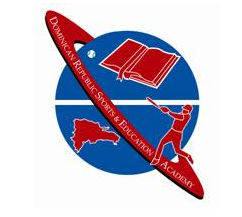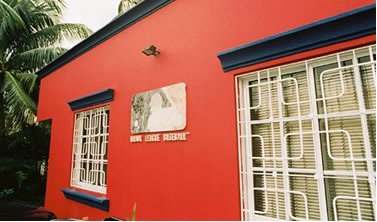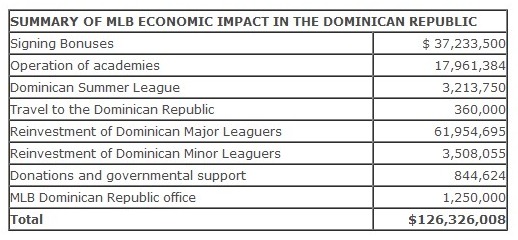Visits: 0
Volume IV, Issue 4: A Publication For Your Reading Enjoyment
Show Me The Money
The baseball industry is spending more money in the Dominican Republic than I previously believed, according to the latest economic impact study by Major League Baseball.
At an astounding $126,326,008, the annual expenditures are over $25 million more than I had calculated, and is $50 million more than presented in Major League Baseball’s first economic impact profile in 2003, meaning baseball’s financial impact on the island continues to grow.
According to Major League Baseball, several factors have contributed to the increase in investment in the Dominican Republic, most directly the production of quality players, coaches, scouts and other baseball personnel. But there have also been negatives that have affected the investment as well, including age and identity fraud, steroid usage and increasing competition from other countries in the development of prospects, leading baseball to ponder the sustainability of its substantial investment.
Prospects were paid $37,233,500 in signing bonuses during the 2009 calendar year, Major League Baseball said, actually a decrease from the previous year. MLB said the fluctuations in signing bonuses reflect supply and demand in the baseball marketplace, as well as the fact teams are less willing to take monetary risks as a result of age and identity fraud, which is viewed as a detriment to the growth of the baseball industry in the Dominican Republic.
A whopping $17,961,384 was spent in 2009 for player development academies, according to the economic study, which reports that currently there are 30 academies in the Dominican Republic operated by major league teams, as well as six in Venezuela and one in Brazil, for a total of 37 camps in Latin America.
An additional $3,213,750 was spent on operating the Dominican Summer League, originally created in 1985 as a development platform for prospects who did not have a visa to travel to the United States. It has become one of the most productive minor league systems with 326 players from various nationalities in the majors.
Teams spent $360,000 for travel to the Dominican Republic to observe and monitor scouting and player development.
The economic impact study also factored in Dominican Major League players’ salaries and the percentage directly reinvested in the Dominican Republic. Conservatively estimating that 20 percent of those salaries directly comes into the Dominican Republic, Major League Baseball calculated the reinvestment using the opening day roster for 2010 – with 77 Dominicans earning a total of $309,773,477 – for an assumed 20 percent reinvestment of $61,954,695. Major League Baseball added in its report, “Although we do not quantify the economic impact of former players, it is important to mention their investment in real estate and businesses that have a recurring positive impact on the local economy.”
Major League Baseball also calculated minor league players’ salaries, and the percentage reinvested in the country was estimated at 50 percent, for a total of $3,508,055.
Baseball also contributed $844,624 in donations and support for governmental institutions in the Dominican Republic, including to the National Baseball Commissioner of the Dominican Republic, community initiatives financed by USAID, and the Dominican Republic RBI (Reviving Baseball in Inner Cities) programs. Major League Baseball also pointed out that its economic impact has fostered donations and support from other sources that directly or indirectly benefit the Dominican Republic including charity golf tournaments, holiday activities and others. It was noted in the report that more than $3,379,500 was donated to Haiti earthquake relief through baseball related sources.
And finally, $1,250,000 was spent on operating Major League Baseball’s office in the Dominican Republic. The size and operating budget have increased as investment by teams has increased over the past decade. The office opened in 2000, a few months after a delegation I led to the Dominican Republic at Major League Baseball’s behest filed a report citing the need to improve conditions at existing academies.
One economic impact that could not be calculated was that on the informal sector of the economy whose operations and income depend on Major League Baseball and its teams. “Although it is difficult to place an amount on this value,” the report said, “we witness hundreds of leagues, agents, and independent trainers that develop activities to sign prospects. During the last five years, the investment by the informal baseball sector has grown significantly with the operation of new and more sophisticated academies and programs.”
And there was one more important impact the industry has, according to Major League Baseball; that of “name recognition,” having projected the name of the Dominican Republic to many parts of the world. “Due to the efforts of many star players and managers, many foreigners know the name of the Dominican Republic through its baseball players,” the report stated. “As the country seeks to increase its exports and tourist potential to the US, Canadian and Japanese markets, the names of its baseball players become an important asset.”
By The Numbers
The Dominican Republic has again led the way in delivering the most foreign-born players to Major League Baseball this season.
According to MLB, there were 846 players on season-opening rosters (749 on 25-man rosters and 97 on disabled or restricted players). Of that number, there were 234 players who were born outside the United States, meaning that 27.7 percent of players this season are foreign born, representing 14 countries and territories.
The Dominican Republic delivered the most players with 86. Next is Venezuela with 62, Puerto Rico with 20 and Canada has 16.
The New York Yankees have 16 foreign-born players, the most of any team in the majors. Four teams rank second with 11 foreign-born players (Colorado Rockies, Detroit Tigers, Los Angeles Angels and Los Angeles Dodgers). The Milwaukee Brewers have eight players born in countries other than the United States.
Last season, there were 231 foreign-born players. This season’s percentage of foreign-born players is down slightly from the all-time high of 29.2 per cent in 2005.








One Comment
You must be logged in to post a comment Login